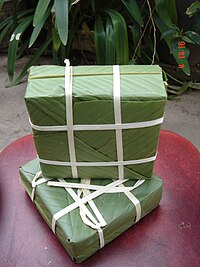Bánh chưng

Bánh chưng is a traditional Vietnamese food consisting of glutinous rice in a square shape wrapped in dong leaves (Phrynium placentarium; lá dong in Vietnamese; a relative of arrowroot) and stuffed with mung beans, fatty pork, and black pepper. It is traditionally eaten during the Lunar New Year (Tết). Bánh chưng is served with pickled scallions, vegetable pickles or "dưa món", and/or fish sauce.
A few days before Tết, family members gather to prepare sticky rice, pork, mung beans, and banana leaves. Making bánh chưng requires a lot of care, from choosing ingredients to the preparation and cooking process. Bánh chưng are boiled for approximately 8 hours. Because bánh chưng have to be watched until they are done, the cooks gather their friends and neighbors to talk during the cooking night.
Traditionally, every house must have at least one or a pair of bánh chưng to be placed on their ancestor's altars. Before Tet, families often offer gifts of bánh chưng to other families, and it is typical for a family to end up with piles left of uneaten bánh chưng long past the holiday.
Legendary
According to an ancient tale, bánh chưng was invented by Lang Liêu who was the winner in a King- choosing contest in Hung Vuong dynasty. The problem is that whoever can offer ancestors the best dish would be the next King. Lang Liêu came to the throne because bánh chưng symbolizes the Earth with rice are the soil and mineral, mung bean is plant as well as meat are animal and people (and also bánh dày symbolizes the Heaven). As the cake contains that meaningful philosophy value, next generations continue to follow this tradition that offering bánh chưng and bánh dày in Tết holiday.
